
US Marine Corps, December 05, 2019 - MARINE CORPS BASE CAMP LEJEUNE, NC by Lance Cpl Taylor Smith - Students with the Basic Landing Support Specialist Course have spent the last 24 days learning how to perform in a helicopter support team (HST).
On Nov. 5, 2019 the students put their knowledge to the test on the Condor Range at Marine Corps Base Camp Lejeune.
Landing support specialists perform various duties that support the establishment, maintenance and control of transportation throughout systems on beaches, landing zones, ports (air and sea) and terminals used in support of Marine Air-Ground Task Force (MAGTF) operations and deployments.
According to the course manager, Sgt. Justin Fortier, one of the key jobs for a landing support specialist is conducting external lifts with a helicopter.
“It is one of the quickest ways to move things in and out of the fight,” said Fortier. “We can move things to remote locations and do things that would otherwise be difficult.”
The HST is one of the best ways to resupply units on the ground when in the battlefield. Supplies get to the location quicker and safer and instead of sending out a convoy into the city with supplies that could possibly be hit by an improvised explosion device, the HST allows the unit to rig up a net load and bring it down to the battlefield.
This capability does not come without its dangers, as aircraft propeller wings generate around 25,000 to 300,000 volts of static electricity, therefore if one person doesn’t do their job correctly, it can mean catastrophic failure. Teamwork is essential to the task, Fortier said.
“Knowing that the person to the left and right of you is actually taking care of you and risking their life for you -- that is the most important thing when you are out there,” said Pfc. David Gonzales, a student in the Basic Landing Support Specialist Course .
The history of the landing support specialist goes back to WWII and the Battle of Guadalcanal. The distinct red patch the Marines wear has earned them the nickname Red Patchers.
“It’s a tradition, rather than a necessity, said Pfc. Joseluis Castaneda, a student in the Basic Landing Support Specialist Course. “It is an honor to wear the same red patch on my uniform as the Marines that came before me.”
The tradition of the red patch that began during the Pacific island campaign of WWII. After the initial beach assault, additional troops would come ashore. Confusion on the beach led to the creation of a red patch to distinguish the landing support Marines from the infantry Marines. The red patch is placed on the side of both legs, below the cargo pocket, and on the front of their covers.
The landing support specialist is a vital role to Marines both forward- deployed and stateside.
On Nov. 5, 2019 the students put their knowledge to the test on the Condor Range at Marine Corps Base Camp Lejeune.
Landing support specialists perform various duties that support the establishment, maintenance and control of transportation throughout systems on beaches, landing zones, ports (air and sea) and terminals used in support of Marine Air-Ground Task Force (MAGTF) operations and deployments.
According to the course manager, Sgt. Justin Fortier, one of the key jobs for a landing support specialist is conducting external lifts with a helicopter.
“It is one of the quickest ways to move things in and out of the fight,” said Fortier. “We can move things to remote locations and do things that would otherwise be difficult.”
The HST is one of the best ways to resupply units on the ground when in the battlefield. Supplies get to the location quicker and safer and instead of sending out a convoy into the city with supplies that could possibly be hit by an improvised explosion device, the HST allows the unit to rig up a net load and bring it down to the battlefield.
This capability does not come without its dangers, as aircraft propeller wings generate around 25,000 to 300,000 volts of static electricity, therefore if one person doesn’t do their job correctly, it can mean catastrophic failure. Teamwork is essential to the task, Fortier said.
“Knowing that the person to the left and right of you is actually taking care of you and risking their life for you -- that is the most important thing when you are out there,” said Pfc. David Gonzales, a student in the Basic Landing Support Specialist Course .
The history of the landing support specialist goes back to WWII and the Battle of Guadalcanal. The distinct red patch the Marines wear has earned them the nickname Red Patchers.
“It’s a tradition, rather than a necessity, said Pfc. Joseluis Castaneda, a student in the Basic Landing Support Specialist Course. “It is an honor to wear the same red patch on my uniform as the Marines that came before me.”
The tradition of the red patch that began during the Pacific island campaign of WWII. After the initial beach assault, additional troops would come ashore. Confusion on the beach led to the creation of a red patch to distinguish the landing support Marines from the infantry Marines. The red patch is placed on the side of both legs, below the cargo pocket, and on the front of their covers.
The landing support specialist is a vital role to Marines both forward- deployed and stateside.


See also |
MH/CH-53E in




